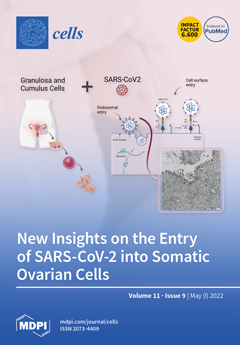Background & aims: Cholangiocytes are the target cells of liver diseases that are characterized by biliary senescence (evidenced by enhanced levels of senescence-associated secretory phenotype, SASP, e.g., TGF-β1), and liver inflammation and fibrosis accompanied by altered bile acid (BA) homeostasis. Taurocholic acid (TC)
[...] Read more.
Background & aims: Cholangiocytes are the target cells of liver diseases that are characterized by biliary senescence (evidenced by enhanced levels of senescence-associated secretory phenotype, SASP, e.g., TGF-β1), and liver inflammation and fibrosis accompanied by altered bile acid (BA) homeostasis. Taurocholic acid (TC) stimulates biliary hyperplasia by activation of 3′,5′-cyclic cyclic adenosine monophosphate (cAMP) signaling, thereby preventing biliary damage (caused by cholinergic/adrenergic denervation) through enhanced liver angiogenesis. Also: (i) α-calcitonin gene-related peptide (α-CGRP, which activates the calcitonin receptor-like receptor, CRLR), stimulates biliary proliferation/senescence and liver fibrosis by enhanced biliary secretion of SASPs; and (ii) knock-out of α-CGRP reduces these phenotypes by decreased cAMP levels in cholestatic models. We aimed to demonstrate that TC effects on liver phenotypes are dependent on changes in the α-CGRP/CALCRL/cAMP/PKA/ERK1/2/TGF-β1/VEGF axis. Methods: Wild-type and
α-CGRP−/− mice were fed with a control (BAC) or TC diet for 1 or 2 wk. We measured: (i) CGRP levels by both ELISA kits in serum and by
qPCR in isolated cholangiocytes (CALCA gene for α-CGRP); (ii) CALCRL immunoreactivity by immunohistochemistry (IHC) in liver sections; (iii) liver histology, intrahepatic biliary mass, biliary senescence (by β-GAL staining and double immunofluorescence (IF) for p16/CK19), and liver fibrosis (by Red Sirius staining and double IF for collagen/CK19 in liver sections), as well as by
qPCR for senescence markers in isolated cholangiocytes; and (iv) phosphorylation of PKA/ERK1/2, immunoreactivity of TGF-β1/TGF- βRI and angiogenic factors by IHC/immunofluorescence in liver sections and
qPCR in isolated cholangiocytes. We measured changes in BA composition in total liver by liquid chromatography/mass spectrometry. Results: TC feeding increased CALCA expression, biliary damage, and liver inflammation and fibrosis, as well as phenotypes that were associated with enhanced immunoreactivity of the PKA/ERK1/2/TGF-β1/TGF-βRI/VEGF axis compared to BAC-fed mice and phenotypes that were reversed in α-CGRP
−/− mice fed TC coupled with changes in hepatic BA composition. Conclusion: Modulation of the TC/ α-CGRP/CALCRL/PKA/ERK1/2/TGF-β1/VEGF axis may be important in the management of cholangiopathies characterized by BA accumulation.
Full article






